A Review of the Data-Driven Prediction Method of Vehicle Fuel Consumption
Abstract
1. Introduction
2. Data Analysis of Vehicle Fuel Consumption
3. Prediction Models of Vehicle Fuel Consumption
3.1. SVM Model
3.2. RF Model
3.3. Neural Network Model
3.4. Deep Neural Network
4. Summaries and Prospects
4.1. Summaries
- (1)
- In the study of the data-driven fuel consumption prediction models, since the fuel consumption process of vehicles is affected by multiple time-varying factors (such as the vehicle running state, driver habits, and driving environment), it is necessary to further consider the problem of poor fit caused by data coupling and so on. To solve this problem, PCA and other methods can be used to reduce the extraction of redundant features and solve the problem of poor model performance on high-dimensional data sets; the Pearson correlation coefficient method can also be used to analyze and screen out features highly correlated with fuel consumption as the input of the model to further ensure that the model has sufficient accuracy.
- (2)
- Traditional machine learning methods have good predictive performance, but some methods need to extract features manually. Existing studies mainly concentrate on the use of a single scenario set, and the model has poor applicability and limited promotion. Therefore, in the data collection stage, considering the fusion of multi-dimensional features for fuel consumption modeling can effectively improve the accuracy and enhance the generalization capacity of the model.
- (3)
- The prediction models of fuel consumption based on neural networks have high accuracy and stability in prediction, but they are too dependent on the size of input data. When the input data are insufficient, it is easy to show poor generalization ability or overfitting problems. To solve this problem, data enhancement can be used to increase the number of samples and maximize the utilization of sample data.
- (4)
- The accuracy of fuel consumption prediction models largely depends on the quality and quantity of input data. Vehicle sensor data are widely used for their advantages of accuracy, reliability, large data volume, and low cost, but there are some problems, such as transmission delay. Using smartphones to obtain data is more real-time, efficient, and convenient. Therefore, in the future, rapid and comprehensive data collection can be achieved by combining onboard sensing devices and smartphones. In addition, when using large-scale datasets for model training, the generalization ability of the model can be effectively improved by using normalization and other processing methods in the preprocessing stage.
- (5)
- The hybrid fuel consumption model is composed of different machine learning methods, which can synthesize the advantages of multiple models to deal with more complex tasks, with strong nonlinear expression ability and good model robustness. However, the structure of this model is complex, the calculation is large, the parameters are not easy to determine, and there are drawbacks in practical application.
4.2. Prospects
Author Contributions
Funding
Data Availability Statement
Conflicts of Interest
References
- Yang, N.; Yang, L.; Xu, F.; Han, X.; Liu, B.; Zheng, N.; Li, Y.; Bai, Y.; Li, L.; Wang, J. Vehicle Emission Changes in China under Different Control Measures over Past Two Decades. Sustainability 2022, 14, 16367. [Google Scholar] [CrossRef]
- Wang, J.; Rakha, H.A. Fuel consumption model for heavy duty diesel trucks: Model development and testing. Transp. Res. Part D Transp. Environ. 2017, 55, 127–141. [Google Scholar] [CrossRef]
- Chang, X.; Chen, B.Y.; Li, Q.; Cui, X.; Tang, L.; Liu, C. Estimating Real-Time Traffic Carbon Dioxide Emissions Based on Intelligent Transportation System Technologies. IEEE Trans. Intell. Transp. Syst. 2013, 14, 469–479. [Google Scholar] [CrossRef]
- Huang, W.; Guo, Y.; Xu, X. Evaluation of real-time vehicle energy consumption and related emissions in China: A case study of the Guangdong–Hong Kong–Macao greater Bay Area. J. Clean. Prod. 2020, 263, 121583. [Google Scholar] [CrossRef]
- Hamed, M.A.; Khafagy, M.H.; Badry, R.M. Fuel Consumption Prediction Model using Machine Learning. Int. J. Adv. Comput. Sci. Appl. 2021, 12, 14569. [Google Scholar] [CrossRef]
- Topić, J.; Škugor, B.; Deur, J. Neural Network-Based Prediction of Vehicle Fuel Consumption Based on Driving Cycle Data. Sustainability 2022, 14, 744. [Google Scholar] [CrossRef]
- Hussain, M.; O’ Nils, M.; Lundgren, J.; Carratú, M.; Shallari, I. Selection of optimal parameters to predict fuel consumption of city buses using data fusion. In Proceedings of the 2022 IEEE Sensors Applications Symposium (SAS), Sundsvall, Sweden, 1–3 August 2022; pp. 1–6. [Google Scholar]
- Çapraz, A.G.; Özel, P.; Şevkli, M.; Beyca, Ö.F. Fuel Consumption Models Applied to Automobiles Using Real-time Data: A Comparison of Statistical Models. Procedia Comput. Sci. 2016, 83, 774–781. [Google Scholar] [CrossRef]
- Hassan, M.A.; Salem, H.; Bailek, N.; Kisi, O. Random Forest Ensemble-Based Predictions of On-Road Vehicular Emissions and Fuel Consumption in Developing Urban Areas. Sustainability 2023, 15, 1503. [Google Scholar] [CrossRef]
- Perrotta, F.; Parry, T.; Neves, L.C. Application of machine learning for fuel consumption modelling of trucks. In Proceedings of the 2017 IEEE International Conference on Big Data (Big Data), Boston, MA, USA, 11–14 December 2017; pp. 3810–3815. [Google Scholar]
- Yu, P.; Xi, J.; Yamauchi, H. Time and Environment Dependency Aware Fuel Consumption Tracking Method for Improving Drivers and Trucks Management. In Proceedings of the 2021 36th International Technical Conference on Circuits/Systems, Computers and Communications (ITC-CSCC), Jeju, Republic of Korea, 27–30 June 2021; pp. 1–4. [Google Scholar]
- Yu, P.; Yamauchi, H. A Machine Learning Based Fuel Consumption Saving Method with Time and Environment Dependency Aware Management. In Proceedings of the 2022 5th International Conference on Electronics, Communications and Control Engineering (ICECC 2022), Association for Computing Machinery, New York, NY, USA, 25–27 March 2022; pp. 40–49. [Google Scholar]
- Wysocki, O.; Deka, L.; Elizondo, D. Heavy duty vehicle fuel consumption modelling using artificial neural networks. In Proceedings of the 2019 25th International Conference on Automation and Computing (ICAC), Lancaster, UK, 5–7 September 2019; pp. 1–6. [Google Scholar]
- Sun, R.; Chen, Y.; Dubey, A.; Pugliese, P. Hybrid electric buses fuel consumption prediction based on real-world driving data. Transp. Res. Part D Transp. Environ. 2021, 91, 102637. [Google Scholar] [CrossRef]
- Hien, N.L.H.; Kor, A. Analysis and Prediction Model of Fuel Consumption and Carbon Dioxide Emissions of Light-Duty Vehicles. Appl. Sci. 2022, 12, 803. [Google Scholar] [CrossRef]
- Metlek, S. A new proposal for the prediction of an aircraft engine fuel consumption: A novel CNN-BiLSTM deep neural network model. Aircr. Eng. Aerosp. Technol. 2023, 95, 838–848. [Google Scholar] [CrossRef]
- Wang, J.; Shen, L.; Bi, Y.; Lei, J. Modeling and optimization of a light-duty diesel engine at high altitude with a support vector machine and a genetic algorithm. Fuel 2021, 285, 119137. [Google Scholar] [CrossRef]
- Yang, Y.; Gong, N.; Xie, K.; Liu, Q. Predicting Gasoline Vehicle Fuel Consumption in Energy and Environmental Impact Based on Machine Learning and Multidimensional Big Data. Energies 2022, 15, 1602. [Google Scholar] [CrossRef]
- Shang, R.; Zhang, Y.; Shen, Z.-J.M.; Zhang, Y. Analyzing the Effects of Road Type and Rainy Weather on Fuel Consumption and Emissions: A Mesoscopic Model Based on Big Traffic Data. IEEE Access 2021, 9, 62298–62315. [Google Scholar] [CrossRef]
- Xu, Z.; Wei, T.; Easa, S.; Zhao, X.; Qu, X. Modeling relationship between truck fuel consumption and driving behavior using data from internet of vehicles. Comput. Aided Civ. Infrastruct. Eng. 2018, 33, 209–219. [Google Scholar] [CrossRef]
- Araújo, J.P.C.; Palha, C.A.O.; Martins, F.F.; Silva, H.M.R.D.; Oliveira, J.R.M. Estimation of energy consumption on the tire-pavement interaction for asphalt mixtures with different surface properties using data mining techniques. Transp. Res. Part D Transp. Environ. 2019, 67, 421–432. [Google Scholar] [CrossRef]
- Ahmadi, M.H.; Ahmadi, M.A.; Ashouri, M.; Astaraei, F.R.; Ghasempour, R.; Aloui, F. Prediction of performance of Stirling engine using least squares support machine technique. Mech. Ind. 2016, 17, 506. [Google Scholar] [CrossRef]
- Yao, Y.; Zhao, X.; Liu, C.; Rong, J.; Zhang, Y.; Dong, Z.; Su, Y. Vehicle Fuel Consumption Prediction Method Based on Driving Behavior Data Collected from Smartphones. J. Adv. Transp. 2020, 2020, 9263605. [Google Scholar] [CrossRef]
- Yang, L.; Tian, T.; Xu, Y.; Wu, C. Predicting fuel consumption of grain combine harvesters based on random forest. Trans. CSAE 2021, 37, 275–281. [Google Scholar]
- Liu, X.; Jin, H. High-precision transient fuel consumption model based on support vector regression. Fuel 2023, 338, 127368. [Google Scholar] [CrossRef]
- Asher, Z.D.; Galang, A.A.; Briggs, W. Economic and Efficient Hybrid Vehicle Fuel Economy and Emissions Modeling Using an Artificial Neural Network. SAE Tech. Pap. 2018, 01, 315–322. [Google Scholar]
- Ziółkowski, J.; Oszczypała, M.; Małachowski, J.; Szkutnik-Rogoż, J. Use of Artificial Neural Networks to Predict Fuel Consumption on the Basis of Technical Parameters of Vehicles. Energies 2021, 14, 2639. [Google Scholar] [CrossRef]
- Li, D.; Zhang, X.; Kang, Q.; Tavakkol, E. Estimation of unconfined compressive strength of marine clay modified with recycled tiles using hybridized extreme gradient boosting method. Constr. Build. Mater. 2023, 393, 131992. [Google Scholar] [CrossRef]
- Shi, X.; Yu, X.; Esmaeili-Falak, M. Improved arithmetic optimization algorithm and its application to carbon fiber reinforced polymer-steel bond strength estimation. Compos. Struct. 2023, 306, 116599. [Google Scholar] [CrossRef]
- Barbado, A.; Corcho, Ó. Interpretable machine learning models for predicting and explaining vehicle fuel consumption anomalies. Eng. Appl. Artif. Intell. 2022, 115, 105222. [Google Scholar] [CrossRef]
- Heni, H.; Diop, S.A.; Renaud, J.; Coelho, L.C. Measuring fuel consumption in vehicle routing: New estimation models using supervised learning. Int. J. Prod. Res. 2023, 61, 114–130. [Google Scholar] [CrossRef]
- Abukhalil, T.; Almahafzah, H.; Alksasbeh, M.; Alqaralleh, B.A.Y. Fuel consumption using OBD-II and support vector machine model. J. Robot. 2020, 2020, 9450178. [Google Scholar] [CrossRef]
- Wickramanayake, S.; Bandara, H.M.N.D. Fuel consumption prediction of fleet vehicles using Machine Learning: A comparative study. In Proceedings of the 2016 Moratuwa Engineering Research Conference (MERCon), Moratuwa, Sri Lanka, 5–6 April 2016; pp. 90–95. [Google Scholar]
- Gong, J.; Shang, J.; Li, L.; Zhang, C.; He, J.; Ma, J. A Comparative Study on Fuel Consumption Prediction Methods of Heavy-Duty Diesel Trucks Considering 21 Influencing Factors. Energies 2021, 14, 8106. [Google Scholar] [CrossRef]
- Zhang, J.; Li, K.; Xu, B.; Li, H. Estimation of Vehicle Instantaneous Fuel Consumption Based on Least Square Method. Qiche Gongcheng/Automo. Eng. 2018, 40, 1151–1157. [Google Scholar]
- Zhu, G.; Zhao, L.; Huang, D.; Zhang, P. A method of vehicle fuel consumption estimation based on decision tree. J. Transp. Syst. Eng. Inf. Technol. 2016, 16, 200–206. [Google Scholar]
- Bousonville, T.; Dirichs, M.; Krüger, T. Estimating truck fuel consumption with machine learning using telematics, topology and weather data. In Proceedings of the 2019 International Conference on Industrial Engineering and Systems Management (IESM), Shanghai, China, 25–27 September 2019; pp. 1–6. [Google Scholar]
- Wang, Q.; Zhang, R.; Lv, S.; Wang, Y. Open-pit mine truck fuel consumption pattern and application based on multi-dimensional features and XGBoost. Sustain. Energy Technol. Assess 2021, 43, 100977. [Google Scholar] [CrossRef]
- Zeng, I.Y.; Tan, S.; Xiong, J.; Ding, X.; Li, Y.; Wu, T. Estimation of Real-World Fuel Consumption Rate of Light-Duty Vehicles Based on the Records Reported by Vehicle Owners. Energies 2021, 14, 7915. [Google Scholar] [CrossRef]
- Schone, A.; Byerly, A.; dos Santos, E.C., Jr.; Ben-Miled, Z. Route-Sensitive Fuel Consumption Models for Heavy-Duty Vehicles. SAE Int. J. Commer. Veh. 2021, 14, 85–951. [Google Scholar] [CrossRef] [PubMed]
- Esmaeili-Falak, M.; Benemaran, R.S. Ensemble deep learning-based models to predict the resilient modulus of modified base materials subjected to wet-dry cycles. Geomech. Eng. 2023, 32, 583–600. [Google Scholar]
- Moradi, E.; Miranda-Moreno, L. Vehicular fuel consumption estimation using real-world measures through cascaded machine learning modelling. Transp. Res. Part D Transp. Environ. 2020, 88, 102576. [Google Scholar] [CrossRef]
- Dhanalaxmi, B.; Varsha, M.; Chowdary, K.R.; Mokshitha, P. An Enhanced Fuel Consumption Machine Learning Model Used in Vehicles. J. Phys. Conf. Ser. 2021, 1979, 012068. [Google Scholar] [CrossRef]
- Yamashita, R.-J.; Yao, H.-H.; Huang, S.-W.; Hackman, A. Accessing and constructing driving data to develop fuel consumption forecast model. IOP Conf. Ser. Earth Environ. Sci. 2017, 113, 012217. [Google Scholar] [CrossRef]
- Kim, Y.-R.; Jung, M.; Park, J.-B. Development of a Fuel Consumption Prediction Model Based on Machine Learning Using Ship In-Service Data. J. Mar. Sci. Eng. 2021, 9, 137. [Google Scholar] [CrossRef]
- Tarelko, W.; Rudzki, K. Applying artificial neural networks for modelling ship speed and fuel consumption. Neural Comput. Apppl. 2020, 32, 17379–17395. [Google Scholar] [CrossRef]
- Jeon, M.; Noh, Y.; Shin, Y.; Lim, O.-K.; Lee, K.; Cho, D. Prediction of ship fuel consumption by using an artificial neural network. J. Mech. Sci. Technol. 2018, 32, 5789–5796. [Google Scholar] [CrossRef]
- Baumann, S.; Klingauf, U. Modeling of aircraft fuel consumption using machine learning algorithms. CEAS Aeronaut. J. 2020, 11, 277–287. [Google Scholar] [CrossRef]
- Pan, Z.; Chi, C.; Zhang, J. A Model of Fuel Consumption Estimation and Abnormality Detection based on Airplane Flight Data Analysis. In Proceedings of the 2018 IEEE/AIAA 37th Digital Avionics Systems Conference (DASC), London, UK, 1 September 2018; pp. 1–6. [Google Scholar]
- Katreddi, S.; Thiruvengadam, A. Trip Based Modeling of Fuel Consumption in Modern Heavy-Duty Vehicles Using Artificial Intelligence. Energies 2021, 14, 8592. [Google Scholar] [CrossRef]
- Zargarnezhad, S.; Dashti, R.; Ahmadi, R. Predicting vehicle fuel consumption in energy distribution companies using ANN. Transp. Res. Part D Transp. Environ. 2019, 74, 174–188. [Google Scholar] [CrossRef]
- Ali, S.; Saiied, M.A.; Mohammad, M.A.; Mehmet, S.K. Development of a multi-layer perceptron artificial neural network model to determine haul trucks energy consumption. Int. J. Min. Sci. Technol. 2016, 26, 285–293. [Google Scholar]
- Panapakidis, I.; Sourtzi, V.-M.; Dagoumas, A. Forecasting the Fuel Consumption of Passenger Ships with a Combination of Shallow and Deep Learning. Electronics 2020, 9, 776. [Google Scholar] [CrossRef]
- Bougiouklis, A.; Korkofigkas, A.; Stamou, G. Improving Fuel Economy with LSTM Networks and Reinforcement Learning. In Proceedings of the 27th International Conference on Artificial Neural Networks, Rhodes, Greece, 4–7 October 2018; pp. 230–239. [Google Scholar]
- Valido, M.R.; Gomez-Cardenes, O.; Magdaleno, E. Monitoring Vehicle Pollution and Fuel Consumption Based on AI Camera System and Gas Emission Estimator Model. Sensors 2023, 23, 312. [Google Scholar] [CrossRef]
- Shi, F.; Chen, J.; Xu, Y.; Karimi, H.R. Optimization of Biodiesel Injection Parameters Based on Support Vector Machine. Math. Probl. Eng. 2013, 2013, 893084. [Google Scholar] [CrossRef]
- Zhu, T.; Yin, X.; Na, X.; Li, B. Research on a Novel Vehicle Rollover Risk Warning Algorithm Based on Support Vector Machine Model. IEEE Access 2020, 8, 108324–108334. [Google Scholar] [CrossRef]
- Wang, X.; Chen, X. A Support Vector Method for Modeling Civil Aircraft Fuel Consumption with ROC Optimization. In Proceedings of the 2014 Enterprise Systems Conference, Shanghai, China, 2–3 August 2014; pp. 112–116. [Google Scholar]
- Zhang, X.; Wang, Y.; He, X.; Ji, H.; Li, Y.; Duan, X.; Guo, F. Prediction of Vehicle Driver’s Facial Air Temperature with SVR, ANN, and GRU. IEEE Access 2022, 10, 20212–20222. [Google Scholar] [CrossRef]
- Ma, X.; Zhu, M. Asymmetric ε-band fuzzy support vector regression based on data domain description. In Proceedings of the 27th Chinese Control and Decision Conference (2015 CCDC), Qingdao, China, 23–25 May 2015; pp. 3280–3286. [Google Scholar]
- Li, M.; Wang, W.; De, G.; Ji, X.; Tan, Z. Forecasting Carbon Emissions Related to Energy Consumption in Beijing-Tianjin-Hebei Region Based on Grey Prediction Theory and Extreme Learning Machine Optimized by Support Vector Machine Algorithm. Energies 2018, 11, 2475. [Google Scholar] [CrossRef]
- Zeng, T.; Zhang, C.; Hu, M.; Chen, Y.; Yuan, C.; Chen, J.; Zhou, A. Modelling and predicting energy consumption of a range extender fuel cell hybrid vehicle. Energy 2018, 165, 187–197. [Google Scholar] [CrossRef]
- Zeng, W.; Miwa, T.; Wakita, Y.; Morikawa, T. Exploring trip fuel consumption by machine learning from GPS and CAN bus data. J. East Asia Soc. Transp. Stud. 2015, 11, 906–921. [Google Scholar]
- Li, Y.; Zhou, S.; Liu, J.; Tong, J.; Dang, J.; Yang, F.; Ouyang, M. Multi-objective optimization of the Atkinson cycle gasoline engine using NSGA III coupled with support vector machine and back-propagation algorithm. Energy 2023, 262, 125262. [Google Scholar] [CrossRef]
- Pereira, G.; Parente, M.; Moutinho, J.; Sampaio, M. Fuel Consumption Prediction for Construction Trucks: A Noninvasive Approach Using Dedicated Sensors and Machine Learning. Infrastructures 2021, 6, 157. [Google Scholar] [CrossRef]
- Baumann, S.; Neidhardt, T.; Klingauf, U. Evaluation of the aircraft fuel economy using advanced statistics and machine learning. CEAS Aeronaut. J. 2021, 12, 669–681. [Google Scholar] [CrossRef]
- Lin, K.-C.; Lin, C.-N.; Ying, J.J.-C. Construction of Analytical Models for Driving Energy Consumption of Electric Buses through Machine Learning. Appl. Sci. 2020, 10, 6088. [Google Scholar] [CrossRef]
- Wang, Q.; Zhang, R.; Wang, Y.; Lv, S. Machine Learning-Based Driving Style Identification of Truck Drivers in Open-Pit Mines. Electronics 2020, 9, 19. [Google Scholar] [CrossRef]
- Huang, Y.; Ng, E.C.Y.; Zhou, J.L.; Surawski, N.C.; Lu, X.; Du, B.; Forehead, H.; Perez, P.; Chan, E.F.C. Impact of drivers on real-driving fuel consumption and emissions performance. Sci. Total Environ. 2021, 798, 149297. [Google Scholar] [CrossRef]
- Zhou, M.; Jin, H.; Wang, W. A review of vehicle fuel consumption models to evaluate eco-driving and eco-routing. Transp. Res. Part D Transp. Environ. 2016, 49, 203–218. [Google Scholar] [CrossRef]
- Massoud, R.; Bellotti, F.; Berta, R.; De Gloria, A.; Poslad, S. Exploring Fuzzy Logic and Random Forest for Car Drivers’ Fuel Consumption Estimation in IoT-Enabled Serious Games. In Proceedings of the 2019 IEEE 14th International Symposium on Autonomous Decentralized System (ISADS), Utrecht, The Netherlands, 8–10 April 2019; pp. 1–7. [Google Scholar]
- Hu, Z.; Zhou, T.; Osman, M.T.; Li, X.; Jin, Y.; Zhen, R. A Novel Hybrid Fuel Consumption Prediction Model for Ocean-Going Container Ships Based on Sensor Data. J. Mar. Sci. Eng. 2021, 9, 449. [Google Scholar] [CrossRef]
- Fam, M.L.; Tay, Z.Y.; Konovessis, D. An Artificial Neural Network for fuel efficiency analysis for cargo vessel operation. Ocean. Eng. 2022, 264, 112437. [Google Scholar] [CrossRef]
- Tran, T.A. Design the prediction model of low-sulfur-content fuel oil consumption for M/V NORD VENUS 80,000 DWT sailing on emission control areas by artificial neural networks. Proc. Inst. Mech. Eng. Part M J. Eng. 2019, 233, 345–362. [Google Scholar] [CrossRef]
- Zhang, F.; Martinez, C.M.; Clarke, D.; Cao, D.; Knoll, A. Neural Network Based Uncertainty Prediction for Autonomous Vehicle Application. Front. Neurorob. 2019, 13, 31133839. [Google Scholar] [CrossRef] [PubMed]
- Hegedüs, F.; Gáspár, P.; Bécsi, T. Fast Motion Model of Road Vehicles with Artificial Neural Networks. Electronics 2021, 10, 928. [Google Scholar] [CrossRef]
- Seo, J.; Park, S. Optimizing model parameters of artificial neural networks to predict vehicle emissions. Atmos. Environ. 2023, 294, 119508. [Google Scholar] [CrossRef]
- Huang, J.; Wang, Y.; Liu, Z.; Guan, B.; Long, D.; Du, X. On modeling microscopic vehicle fuel consumption using radial basis function neural network. Soft Comput. 2016, 20, 2771–2779. [Google Scholar] [CrossRef]
- Ling, G.; Lindsten, K.; Ljungqvist, O.; Löfberg, J.; Norén, C.; Larsson, C.A. Fuel-efficient Model Predictive Control for Heavy Duty Vehicle Platooning using Neural Networks. In Proceedings of the 2018 Annual American Control Conference (ACC), Milwaukee, WI, USA, 27–29 June 2018; pp. 3994–4001. [Google Scholar]
- Illahi, A.A.C.; Bandala, A.; Dadios, E.P. Neural Network Modeling for Fuel Consumption Base on Least Computational Cost Parameters. In Proceedings of the 2019 IEEE 11th International Conference on Humanoid, Nanotechnology, Information Technology, Communication and Control, Environment, and Management (HNICEM), Laoag, Philippines, 29 November–1 December 2019; pp. 1–5. [Google Scholar]
- Wu, J.-D.; Liu, J.-C. Development of a predictive system for car fuel consumption using an artificial neural network. Expert Syst. Appl. 2011, 38, 4967–4971. [Google Scholar] [CrossRef]
- Du, Y.; Wu, J.; Yang, S.; Zhou, L. Predicting vehicle fuel consumption patterns using floating vehicle data. J. Environ. Sci. 2017, 59, 24–29. [Google Scholar] [CrossRef]
- Jafarmadar, S.; Khalilaria, S.; Saraee, H.S. Prediction of the Performance and Exhaust Emissions of a Compression Ignition Engine Using a Wavelet Neural Network with a Stochastic Gradient Algorithm. Energy 2018, 142, 1128–1138. [Google Scholar]
- Hu, Z.; Jin, Y.; Hu, Q.; Sen, S.; Zhou, T.; Osman, M.T. Prediction of Fuel Consumption for Enroute Ship Based on Machine Learning. IEEE Access 2019, 7, 119497–119505. [Google Scholar] [CrossRef]
- Witaszek, K. Modeling of fuel consumption using artificial neural networks. Diagnostyka 2020, 21, 103–113. [Google Scholar] [CrossRef]
- Soofastaei, A.; Alamdari, S.; Basiri, M.H.; Mousavi, A. Application of Machine Learning Techniques to Predict Haul Truck Fuel Consumption in Open-Pit Mines. J. Min. Environ. 2022, 13, 69–85. [Google Scholar]
- Schone, A.; Byerly, A.; Hendrix, B.; Bagwe, R.M.; dos Santos, E.C. A machine learning model for average fuel consumption in heavy vehicles. IEEE Trans. Veh. Technol. 2019, 68, 6343–6351. [Google Scholar] [CrossRef]
- Zhao, X.; Yao, Y.; Wu, Y.; Chen, C.; Jian, R. Prediction model of driving energy consumption based on PCA and BP network. J. Transp. Syst. Eng. Inf. Technol. 2016, 16, 185–191. [Google Scholar]
- Zhou, Y.; Zhu, Y.; Wang, L.; Guo, Y. Prediction model of fuel consumption of heavy truck based on improved BP neural network. In Proceedings of the 2022 IEEE Intl Conf on Dependable, Autonomic and Secure Computing, Intl Conf on Pervasive Intelligence and Computing, Intl Conf on Cloud and Big Data Computing, Intl Conf on Cyber Science and Technology Congress (DASC/PiCom/CBDCom/CyberSciTech), Falerna, Italy, 12–15 September 2022; pp. 1–6. [Google Scholar]
- Chen, C.; Chen, Q.; Liu, Q.; Yan, J. Research on vehicle fuel consumption prediction model based on Cauchy mutation multiverse algorithm. In Proceedings of the 2022 9th International Forum on Electrical Engineering and Automation (IFEEA), Zhuhai, China, 4–6 November 2022; pp. 1115–1119. [Google Scholar]
- Wang, K.; Wang, J.; Huang, L.; Yuan, Y.; Wu, G.; Xing, H.; Wang, Z.-Y.; Wang, Z.; Jiang, X. A comprehensive review on the prediction of ship energy consumption and pollution gas emissions. Ocean Eng. 2022, 266, 112826. [Google Scholar] [CrossRef]
- Ko, K.; Lee, T.; Jeong, S. A Deep Learning Method for Monitoring Vehicle Energy Consumption with GPS Data. Sustainability 2021, 13, 11331. [Google Scholar] [CrossRef]
- Li, Y.; Zeng, I.Y.; Niu, Z.; Shi, J.; Wang, Z.; Guan, Z. Predicting vehicle fuel consumption based on multi-view deep neural network. Neurocomputing 2022, 502, 140–147. [Google Scholar] [CrossRef]
- Li, Y.; Tang, G.; Du, J.; Zhou, N.; Zhao, Y.; Wu, T. Multilayer Perceptron Method to Estimate Real-World Fuel Consumption Rate of Light Duty Vehicles. IEEE Access 2019, 7, 63395–63402. [Google Scholar] [CrossRef]
- Carvalho, E.; Ferreira, B.V.; Ferreira, J.; de Souza, C.; Carvalho, H.V.; Suhara, Y.; Pentland, A.S.; Pessin, G. Exploiting the use of recurrent neural networks for driver behavior profiling. In Proceedings of the 2017 International Joint Conference on Neural Networks (IJCNN), Anchorage, AK, USA, 14–19 May 2017; pp. 3016–3021. [Google Scholar]
- Kanarachos, S.; Mathew, J.; Fitzpatrick, M.E. Instantaneous vehicle fuel consumption estimation using smartphones and recurrent neural networks. Expert Syst. Appl. 2019, 120, 436–447. [Google Scholar] [CrossRef]
- Ping, P.; Qin, W.; Xu, Y.; Miyajima, C.; Takeda, K. Impact of Driver Behavior on Fuel Consumption: Classification, Evaluation and Prediction Using Machine Learning. IEEE Access 2019, 7, 78515–78532. [Google Scholar] [CrossRef]
- Kan, Y.; Liu, H.; Lu, X.; Chen, Q. A Deep Learning Engine Power Model for Estimating the Fuel Consumption of Heavy-Duty Trucks. In Proceedings of the 2020 6th IEEE International Energy Conference (ENERGYCon), Gammarth, Tunisia, 28 September–1 October 2020; pp. 182–187. [Google Scholar]
- Jain, N.; Mittal, S. A machine learning pipeline for fuel-economical driving model. Int. J. Intell. Comput. Cybern. 2022, 15, 473–496. [Google Scholar] [CrossRef]
- Wang, G.; Zhang, L.; Xu, Z.; Wang, R.; Hina, S.M.; Wei, T.; Qu, X.; Yang, R. Predictability of Vehicle Fuel Consumption Using LSTM: Findings from Field Experiments. J. Transp. Eng. A Syst. 2023, 149, 04023030. [Google Scholar] [CrossRef]
- Hua, Y.; Sevegnani, M.; Yi, D.; Birnie, A.; McAslan, S. Fine-Grained RNN with Transfer Learning for Energy Consumption Estimation on EVs. IEEE Trans. Ind. Inf. 2022, 18, 8182–8190. [Google Scholar] [CrossRef]
- Aamir, M.; Rahman, Z.; Abro, W.A.; Tahir, M.; Mustajar, S. An Optimized Architecture of Image Classification Using Convolutional Neural Network. Int. J. Image Graph. Signal Process. 2019, 11, 30–39. [Google Scholar] [CrossRef]
- Sharma, N.; Jain, V.; Mishra, A. An Analysis of Convolutional Neural Networks for Image Classification. Procedia Comput. Sci. 2018, 132, 377–384. [Google Scholar] [CrossRef]
- Yan, Q.; Chen, X.; Jian, H.; Wei, W.; Wang, W.; Wang, H. Design of a deep inference framework for required power forecasting and predictive control on a hybrid electric mining truck. Energy 2022, 238, 121960. [Google Scholar] [CrossRef]
- Han, S.; Zhang, F.; Ren, Y.; Xi, J. Predictive Energy Management Strategies in Hybrid Electric Vehicles Using Hybrid Deep Learning Networks. China J. Highw. Transp. 2020, 33, 3352. [Google Scholar]
- Kheirandish, A.; Shafiabady, N.; Dahari, M.; Kazemi, M.S.; Isa, D. Modeling of commercial proton exchange membrane fuel cell using support vector machine. Int. J. Hydrog. Energy 2016, 41, 11351–11358. [Google Scholar] [CrossRef]
- Bera, P. Fuel consumption analysis in dynamic states of the engine with use of artificial neural network. Combust. Engines 2013, 155, 16–25. [Google Scholar] [CrossRef]
- Predić, B.; Madić, M.; Roganovic, M.; Kovačević, M.; Stojanović, D. Prediction of passenger car fuel consumption using artificial neural network: A case study in city of NIŠ. Engineering 2016, 15, 105–116. [Google Scholar]

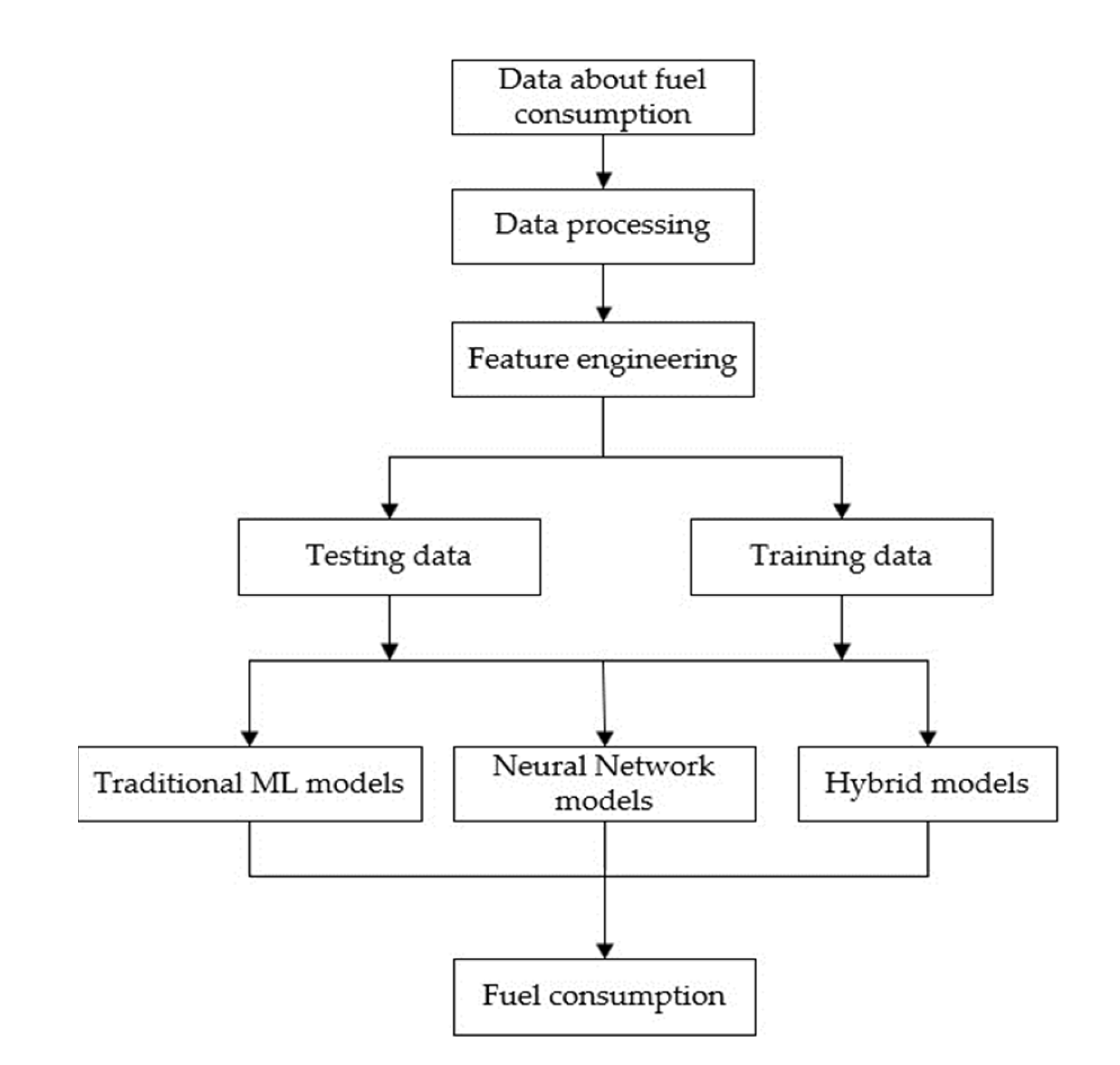
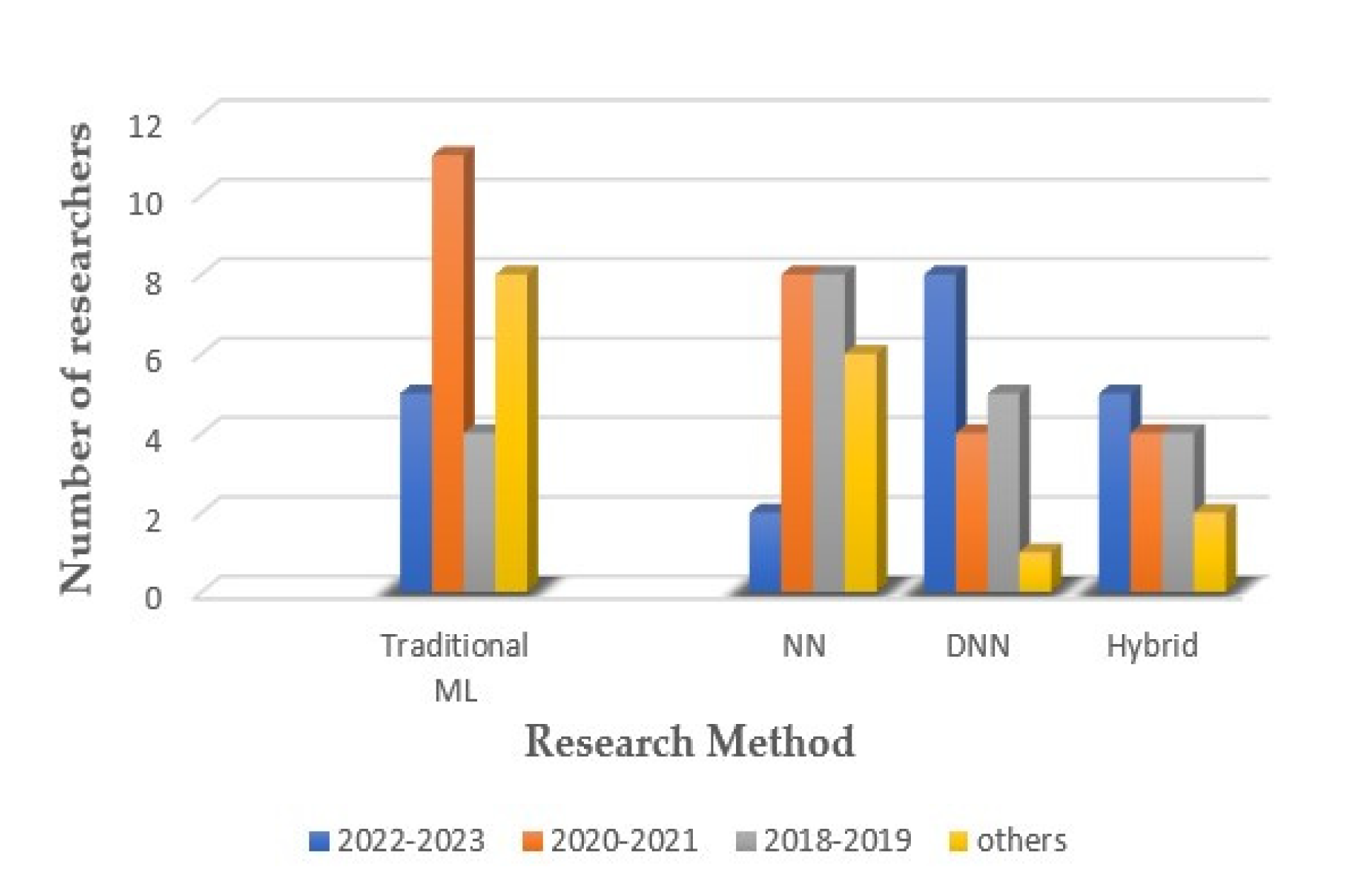
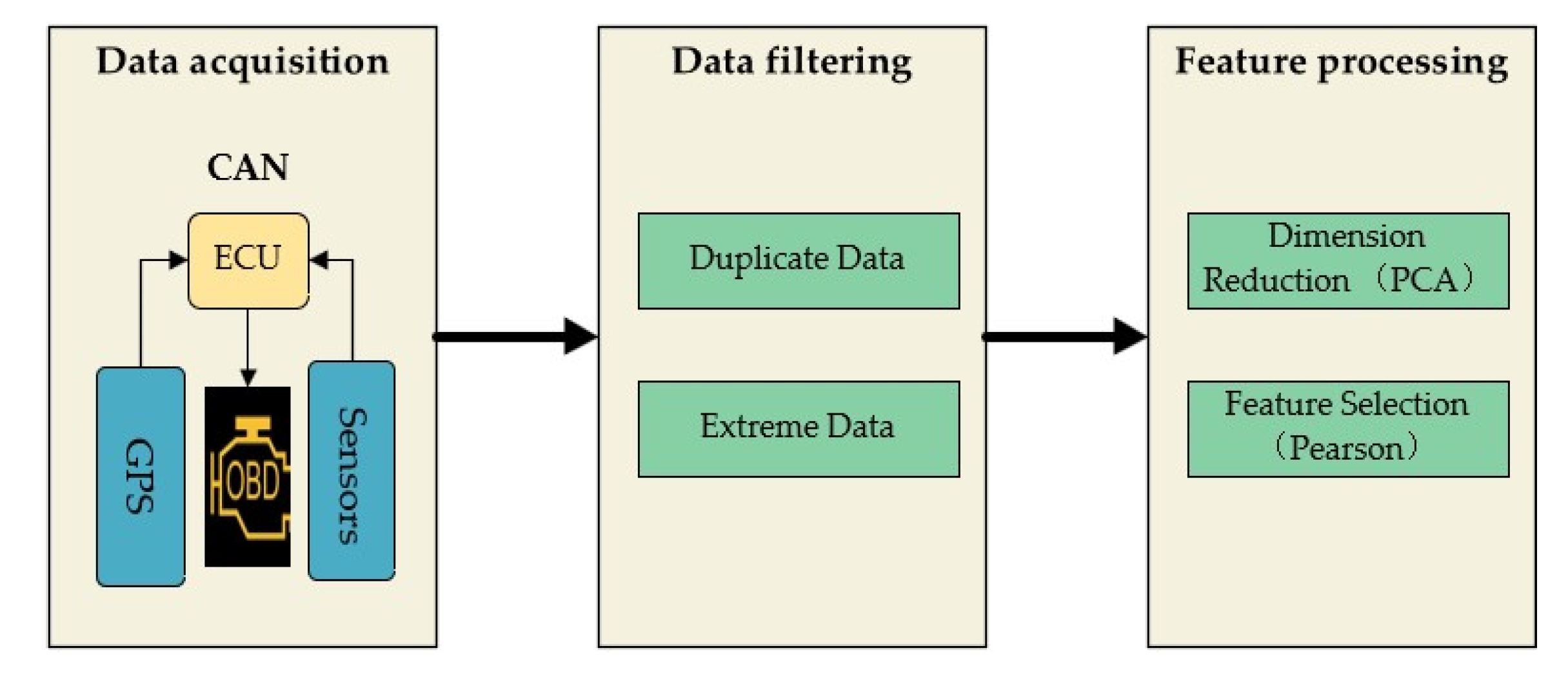
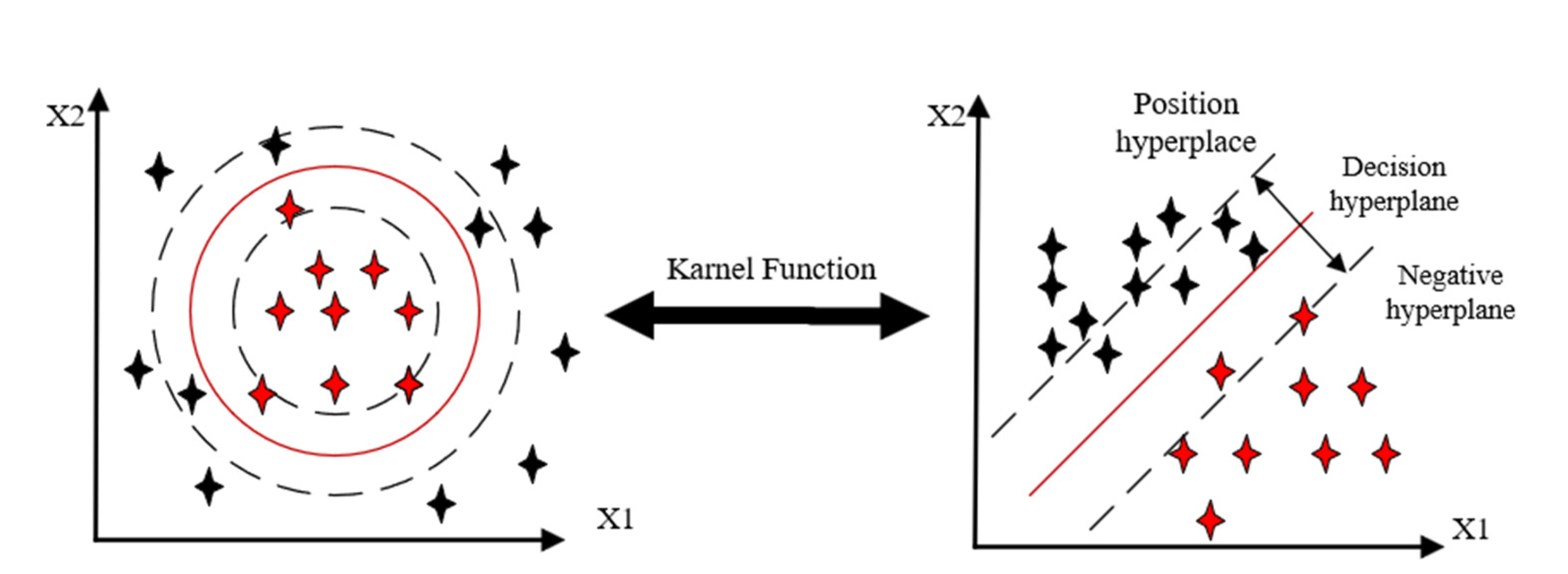
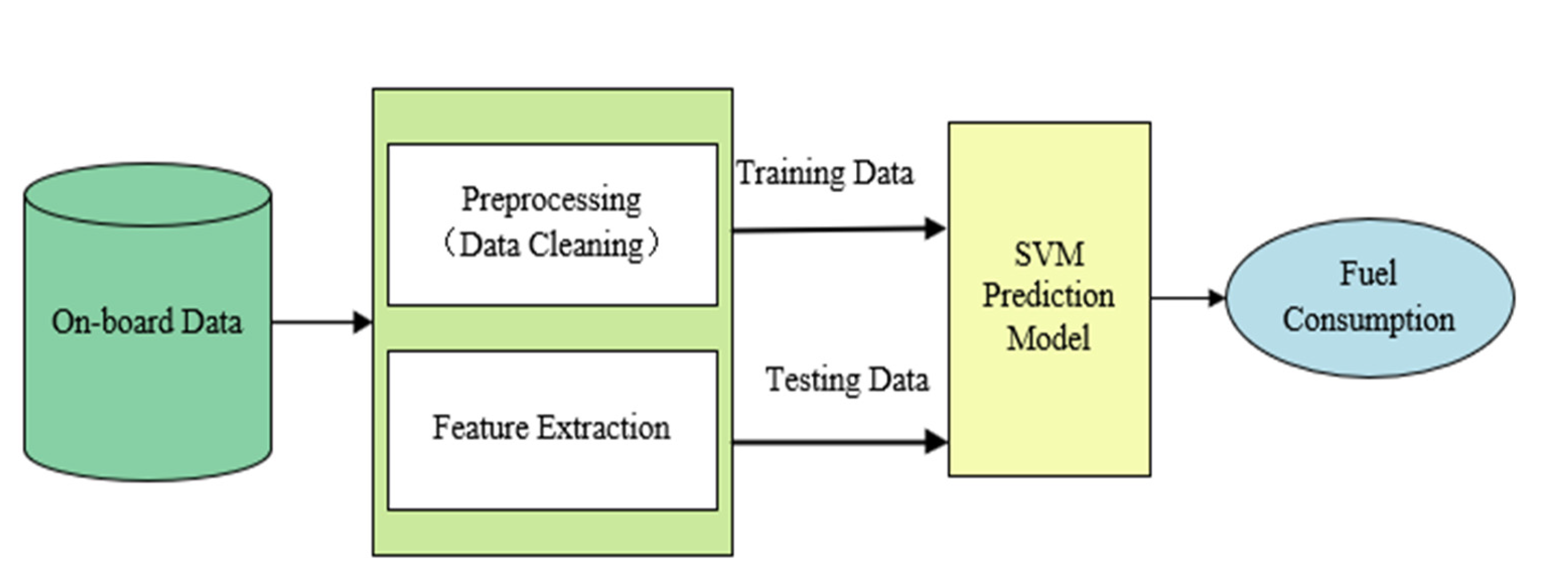

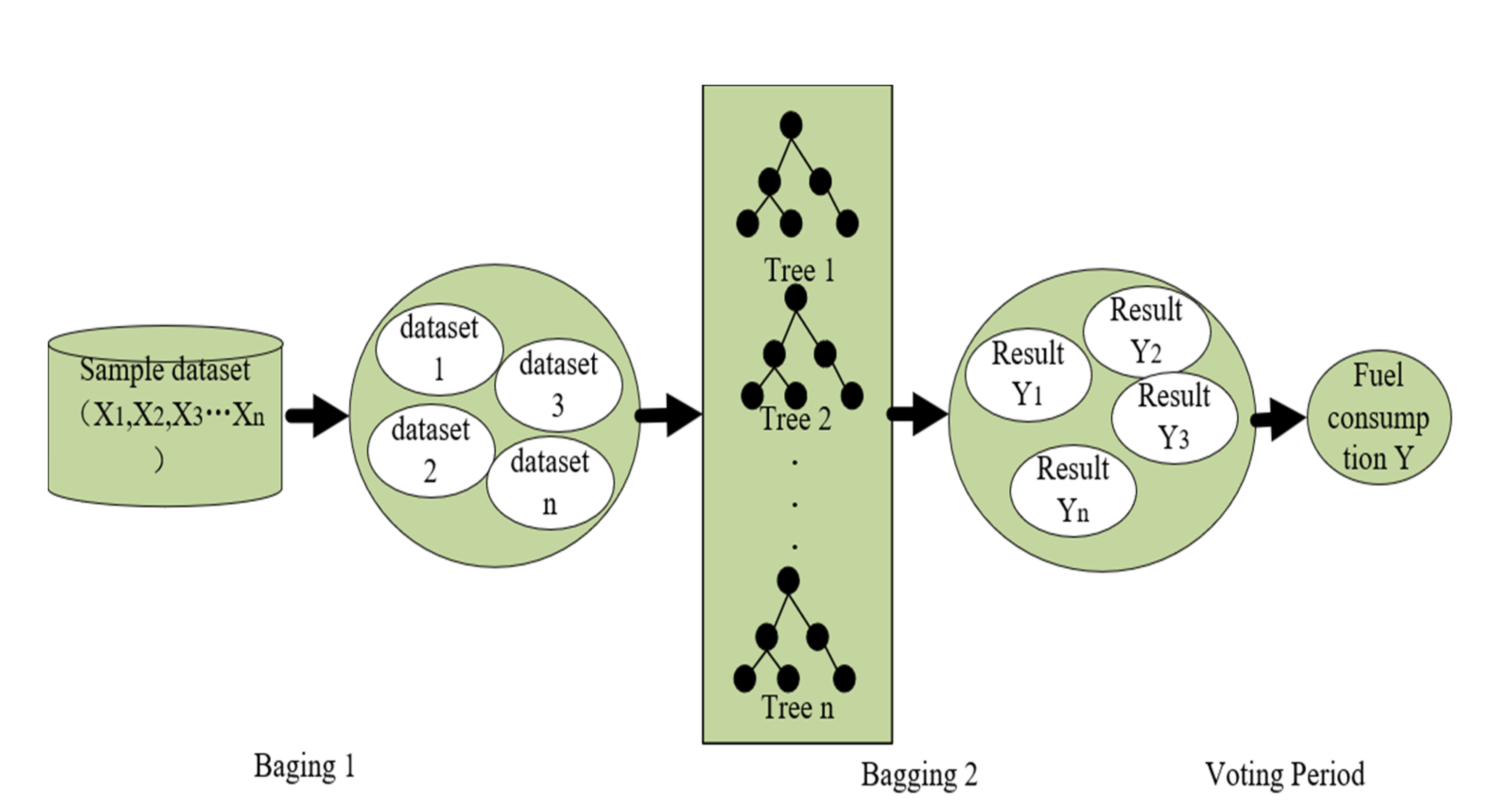
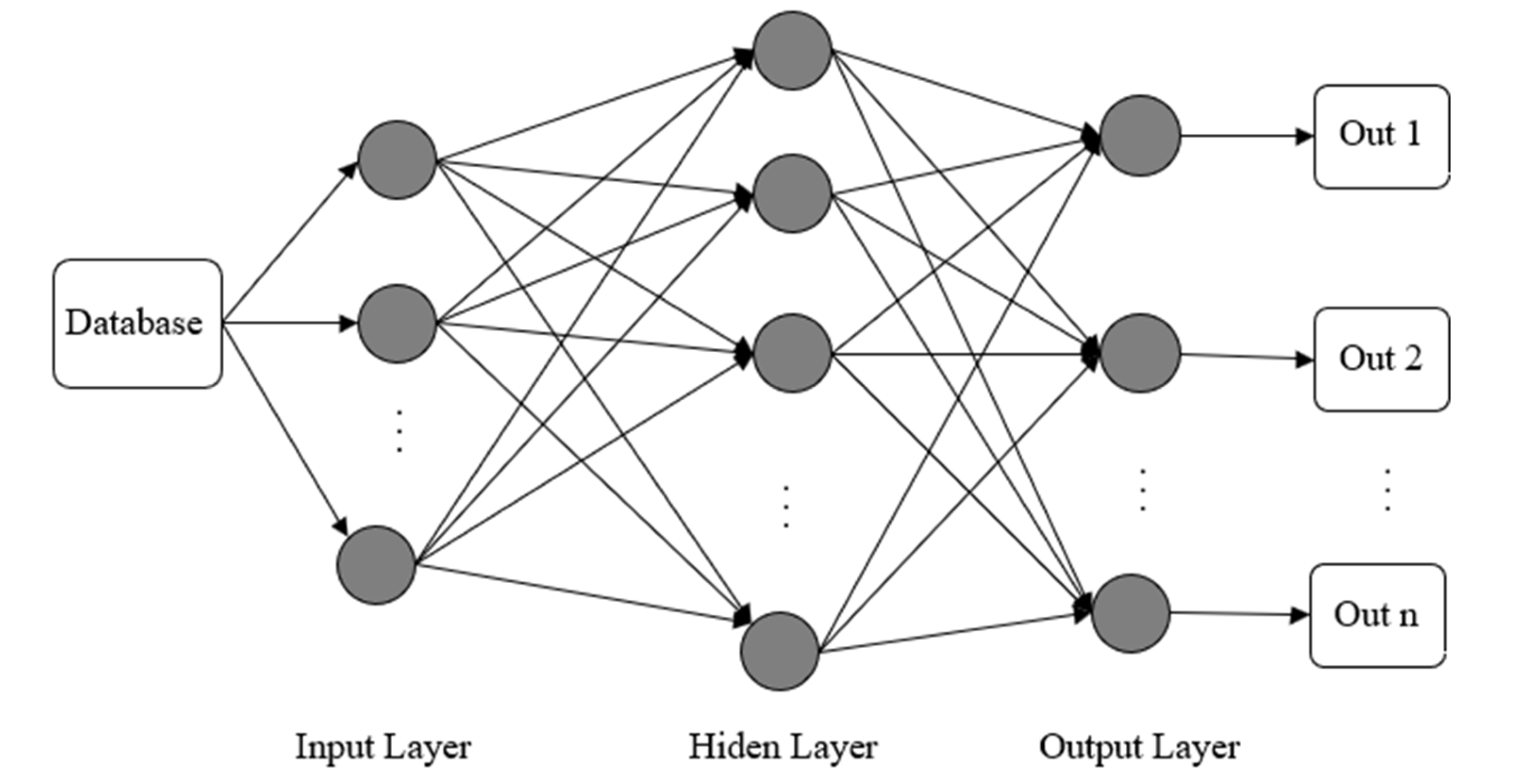

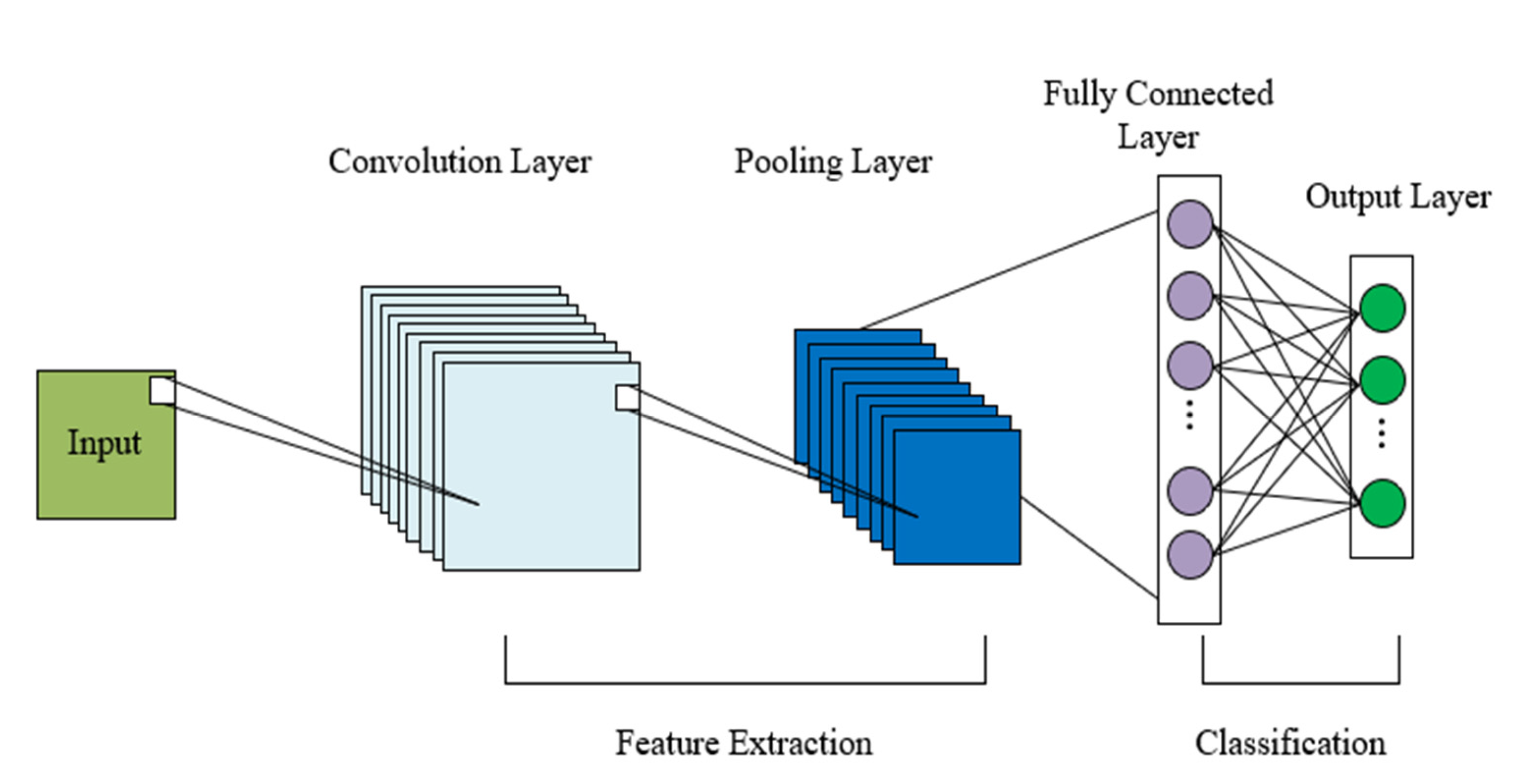

| Index | Equation | Evaluation Standard | Equation No. | References |
|---|---|---|---|---|
| R2 | Range: 0 to 1 Higher is best | (1) | [5,6,7,8,9,10,11,12,13,14,15,16] | |
| MSE | Lower is best | (2) | [17,18,19,20] | |
| RMSE | Lower is best | (3) | [8,9,10,11,13,14,21,22,23,24] | |
| MAE | Lower is best | (4) | [18,24,25,26] | |
| MAPE | Lower is best | (5) | [18,25,27] | |
| SI | < 0.05: higher accuracy; 0.05 < < 0.1: Good accuracy | (6) | [28,29] | |
| U95 | Lower is best | (7) | [28,29] |
| Data Type | Relevant Data | Collection Mode |
|---|---|---|
| Vehicle inherent variables | Vehicle and engine model, engine capacity, total vehicle mass | Provided by the vehicle manufacturer |
| Driving behavior variables | Driving speed and acceleration, engine speed and torque, engine load rate and revolution, driving distance, the real fuel consumption of vehicles | GPS, Gyroscope, OBD-II, CAN bus, Smartphone |
| Driving environment variables | Weather factors, altitude, road slope, and other road conditions information | GPS, Radar, Infrared ray |
| Reference | Model | Inputs | Vehicle Type | Performance | Characteristics |
|---|---|---|---|---|---|
| Abukhalil et al. [32] | SVM | Engine speed, revolutions per minute, speed, etc. | Passenger vehicles | RMSE: 2.43 | Processing large-scale data is inefficient and time-consuming; the model accuracy is low when dealing with noisy data sets. The SVM model is relatively simple and has low requirements for hardware and software. |
| Zeng et al. [63] | SVM | Data collected from GPS and CAN bus (trip distance, speed, engine capacity, etc.) | Probe vehicles | R2: 0.92 | |
| Hussain et al. [7] | SVM | Information from On-board Sensors and records (traveled distance, hour of the day, driver ID, bus ID, etc.) | City buses | R2: 0.95 | |
| Capraz et al. [8] | SVM | Trip distance, speed, vehicle weight, acceleration, road slope, etc. | Passenger vehicles | R2: 0.94 | |
| Araújo et al. [21] | SVM | Load, speed, pendulum test value, mean texture depth, estimating the surface texture depth; load, speed, mean texture depth | Various types of vehicles | RMSE: 0.303 RMSE: 0.410 | |
| Liu et al. [25] | SVR | Engine speed and torque, speed, acceleration, engine oil temperature, etc. | Passenger vehicles | MAE: <0.16 | |
| Ahmadi et al. [22] | LSSVM | Rotation speed, temperature of heat source, pressure, etc. | Stirling engine | RMSE: 0.067 R2: 0.98 | The performance is highly dependent on the model fit and the characteristics of the data set. High computing resources and storage space are required. |
| Wang et al. [17] | GA-SVM | Data from sensors (engine speed and torque, temperature, air mass flow rate, etc.) | Light diesel engine | MSE: 1.344 R2: 0.967 | |
| Li et al. [64] | NSGA-SVM | Speed, load, engine speed, cylinder pressure, etc. | Gasoline engine | Relative error: <3% |
| Reference | Model | Inputs | Vehicle Type | Performance | Characteristics |
|---|---|---|---|---|---|
| Hassan et al. [9] | RF | Vehicle speed, vehicle specific power, engine speed, engine stress | Passenger vehicles | RMSE: 0.15 R2: 0.871 | The effect of processing high-dimensional sparse data is not good. It is difficult to explain the specific reasons for the model prediction; when the number of trees is large, high computing resources and storage space are required. |
| Gong et al. [34] | RF | 21 variables extracted from the driver-vehicle-road-environment | Heavy-duty diesel trucks | Accuracy: 86.58% | |
| Perrotta et al. [10] | RF | Vehicle speed, acceleration, the torque and revolutions of the engine, etc. | Trucks | RMSE: 4.64 R2: 0.87 | |
| Yu et al. [11] | RF | Mileage and speed, temperature, air pressure, etc. | Trucks | RMSE: 5.073R2: 0.98 | |
| Yao et al. [23] | RF | Driving data collected from smartphone applications (speed, acceleration, etc.) | Taxis | RMSE: 0.783 | |
| Yang et al. [18] | RF | Engine power and the number of cylinders, driving speed, driving habits, temperature, wind speed, etc. | Light-duty vehicles | MAE: 0.63 MSE: 0.805 | |
| Yang et al. [24] | RF | Engine speed, engine torque, speed, acceleration, deceleration, etc. | Gain combine harvesters | MAE: 0.24 RMSE: 0.14 | |
| Yu et al. [12] | Hybrid model | Mileage and speed, temperature, air pressure, etc. | Long-distance vehicles | R2: 0.976 | The model is complex and requires high hardware and software. |
| Reference | Model | Inputs | Vehicle Type | Performance | Characteristic |
|---|---|---|---|---|---|
| Wysocki et al. [13] | ANN | Data from the CAN bus (engine speed and torque, etc.) | Heavy-duty trucks | RMSE: 0.32 R2: 0.99 | The parameter setting is complicated, and the result is easily affected by the quality and quantity of input data. High requirements of hardware and software resources of the device. |
| Witaszek [85] | ANN | Vehicle speed and acceleration, road slope, throttle opening degree, selected gear number, and engine speed | Passenger vehicles | Relative error: <3% | |
| Soofastaei et al. [86] | ANN | Data from past records (payload, total resistance, actual speed) | Haul trucks | R2: 0.903 | |
| Asher et al. [26] | ANN | Data from OBD-II (speed, acceleration, engine speed, etc.) | Hybrid vehicles | MAE: 0–0.1% | |
| Schone et al. [87] | FNN | Distance, seven predictors derived from vehicle speed and road slope | Heavy-duty vehicles | RMSE: 0.0132 R2: 0.91 | |
| Topić et al. [6] | FNN | Speed, acceleration, slope time series | City buses | R2: >0.97 | |
| Du et al. [82] | BP | Data from records (time, location, speed, road condition, driver’s personal information, etc.) | Various types of vehicles | Accuracy: 81.7% | Nonlinear mapping strength; easy to fall into local optimal solution; susceptible to initial values; when the data scale is large, the device requires high configuration. |
| Zhao et al. [88] | BP | Data from OBD-II and GPS (distance, acceleration, speed, etc.) | Taxis | Accuracy: 92.46% | |
| Shang et al. [19] | HMM-BP | Data from records (vehicle ID, vehicle speed, moving direction, GPS longitude, latitude, etc.) | Taxis | MSE: <0.06 R2: >0.95 | The performance is highly dependent on the model fit and the characteristics of the data set. High computing resources and storage space are required. |
| Zhou et al. [89] | GSA-BP | Engine speed and torque, vehicle speed, load rate, driving distance, etc. | Heavy duty vehicles | Accuracy: 96.51% | |
| Chen et al. [90] | CMVO-BP | Vehicle speed, engine speed, and torque | Truck | Accuracy: 97.5% |
| Model Type | Traditional Machine Learning Model [7,8,9,10,11,21,23,106] | Neural Network Model [13,82,85,86,88,107,108] | DNN Model [15,20,97,98,99] | Hybrid Model [16,72,89,90] |
|---|---|---|---|---|
| Interpretability | Good | Middle | poor | Poor |
| Efficiency | High | Middle | Low | Low |
| Accuracy | Low | Middle | High | High |
| Advantages | Simple model, suitable for processing small sample data (SVM) and high dimensional data (RF) | Strong nonlinear mapping ability, relatively simple structure | Can process data related to timing (RNN, LSTM), automatic feature extraction, model stability | Suitable for all kinds of scenarios, accepts input from different types of data |
| Disadvantages | Features need to be extracted manually, poor performance when dealing with large amounts of data | Easy to fall into local optimality (BPNN), features related to timing cannot be obtained | Computationally heavy, over-reliance on the amount of input data | The model structure is complex, and parameter adjustment difficulty |
Disclaimer/Publisher’s Note: The statements, opinions and data contained in all publications are solely those of the individual author(s) and contributor(s) and not of MDPI and/or the editor(s). MDPI and/or the editor(s) disclaim responsibility for any injury to people or property resulting from any ideas, methods, instructions or products referred to in the content. |
© 2023 by the authors. Licensee MDPI, Basel, Switzerland. This article is an open access article distributed under the terms and conditions of the Creative Commons Attribution (CC BY) license (https://creativecommons.org/licenses/by/4.0/).
Share and Cite
Zhao, D.; Li, H.; Hou, J.; Gong, P.; Zhong, Y.; He, W.; Fu, Z. A Review of the Data-Driven Prediction Method of Vehicle Fuel Consumption. Energies 2023, 16, 5258. https://doi.org/10.3390/en16145258
Zhao D, Li H, Hou J, Gong P, Zhong Y, He W, Fu Z. A Review of the Data-Driven Prediction Method of Vehicle Fuel Consumption. Energies. 2023; 16(14):5258. https://doi.org/10.3390/en16145258
Chicago/Turabian StyleZhao, Dengfeng, Haiyang Li, Junjian Hou, Pengliang Gong, Yudong Zhong, Wenbin He, and Zhijun Fu. 2023. "A Review of the Data-Driven Prediction Method of Vehicle Fuel Consumption" Energies 16, no. 14: 5258. https://doi.org/10.3390/en16145258
APA StyleZhao, D., Li, H., Hou, J., Gong, P., Zhong, Y., He, W., & Fu, Z. (2023). A Review of the Data-Driven Prediction Method of Vehicle Fuel Consumption. Energies, 16(14), 5258. https://doi.org/10.3390/en16145258







